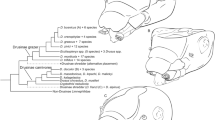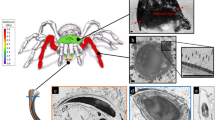Abstract
IT is well known that arthropods found in Baltic amber are unusually well preserved, so that even the minutest features of their chitinous structures are plainly visible under considerable magnification. The internal organs, however, are usually completely disintegrated, nothing but the amber mould of the chitinous skeleton remaining. It was therefore something of a pleasant surprise to discover a specimen of an amber fungus-gnat in which the flexor and extensor muscles of the tibia, located in the femur, are so well preserved in all legs, that not only their outlines, but also the transverse striations of the fibres, may be clearly seen under the microscope at a linear magnification of 300:1 (see Fig. 1).
This is a preview of subscription content, access via your institution
Access options
Subscribe to this journal
Receive 51 print issues and online access
$199.00 per year
only $3.90 per issue
Buy this article
- Purchase on Springer Link
- Instant access to full article PDF
Prices may be subject to local taxes which are calculated during checkout
Similar content being viewed by others
References
Bashford Dean, “Presence of Muscle Fibres in Sharks of the Cleveland Shale”, Amer. Geol., 39; 1902.
Author information
Authors and Affiliations
Rights and permissions
About this article
Cite this article
PETRUNKEVITCH, A. Striated Muscles of an Amber Insect. Nature 135, 760–761 (1935). https://doi.org/10.1038/135760c0
Issue Date:
DOI: https://doi.org/10.1038/135760c0
This article is cited by
-
Unparalleled details of soft tissues in a Cretaceous ant
BMC Ecology and Evolution (2022)
Comments
By submitting a comment you agree to abide by our Terms and Community Guidelines. If you find something abusive or that does not comply with our terms or guidelines please flag it as inappropriate.



